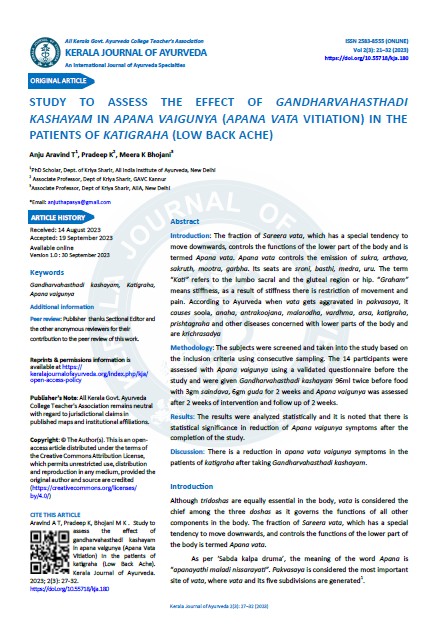STUDY TO ASSESS THE EFFECT OF GANDHARVAHASTHADI KASHAYAM IN APANA VAIGUNYA (APANA VATA VITIATION) IN THE PATIENTS OF KATIGRAHA (LOW BACK ACHE)
DOI:
https://doi.org/10.55718/kja.180Keywords:
Gandharvahasthadi kashayam, Katigraha, Apana vaigunyaAbstract
Introduction: The fraction of Sareera vata, which has a special tendency to move downwards, controls the functions of the lower part of the body and is termed Apana vata. Apana vata controls the emission of sukra, arthava, sakruth, mootra, garbha. Its seats are sroni, basthi, medra, uru. The term “Kati” refers to the lumbo sacral and the gluteal region or hip. “Graham” means stiffness, as a result of stiffness there is restriction of movement and pain. According to Ayurveda when vata gets aggravated in pakvasaya, it causes soola, anaha, antrakoojana, malarodha, vardhma, arsa, katigraha, prishtagraha and other diseases concerned with lower parts of the body and are krichrasadya
Methodology: The subjects were screened and taken into the study based on the inclusion criteria using consecutive sampling. The 14 participants were assessed with Apana vaigunya using a validated questionnaire before the study and were given Gandharvahasthadi kashayam 96ml twice before food with 3gm saindava, 6gm guda for 2 weeks and Apana vaigunya was assessed after 2 weeks of intervention and follow up of 2 weeks.
Results: The results were analyzed statistically and it is noted that there is statistical significance in reduction of Apana vaigunya symptoms after the completion of the study.
Discussion: There is a reduction in apana vata vaigunya symptoms in the patients of katigraha after taking Gandharvahasthadi kashayam.
References
Acharya Susrutha. SusruthaSamhitha (vol 2). Translated by P. V. Sharma. Varanasi: ChaukambhaVisvabharathi; 2013 reprint. Nidana 1/19, Vatavyadhinidanam; p. 6.
AcharyaAgnivesa. CharakaSamhitha (vol 5). 2 Ed. Translated by Ram Karan Sharma, Bhagwan Dash. Varanasi: Chaukambha Sanskrit series; 2001. Chikitsa 28/19; p. 21.
Constipation, diarrhoea. http://www.niddk.nih.gov/health-information/digestive diseases (accessed 12/6/2020).
AcharyaShodala. Gadanigrahavidhodhinivyakhya(vol 1). Translated by IndradevTripadi, Varanasi: chaukhambha Sanskrit sansthan; reprint 2005. KayachiktsakhandaVatavyadhichikitsa 16/160; p. 508
S H Ralston, I B Mclnnes. Rheumatology and bone diseases. Brian R Walker, Nicki R Colledge, Stuart H Ralston, Ian D Palman. Davidson's Principles and practise of Medicine, 22 ed. United States: Churchill Livingstone Elsevier; 2014. pp. 1072
Mathew AC, Safar RS, Anithadevi TS, Banu MS, Ravi Shankar SL, Rai BD, Chacko TV. The prevalence and correlates of low back pain in adults: A cross-sectional study from Southern India. Int J Med Public Health 2013;3:342-6
Krishnan vaidyan K V, Gopalapillai S. Sahasrayogam. 24 Ed. Aleppy: VidyarambhamPulishers; 2002. p. 78
Acharya Vagbhata. AshtangaHridaya (Vol 1). 10 ed. Translated by K.R. Srikanta Murthy, Varanasi: ChowkhambaKrishnadas Academy; 2014. Sutra, Doshopakramaneeya8/25; p. 187.
P K Warrier, V P K Nambiar. Indian Medicinal Plants (Vol 5). Chennai: Orient Longman Private Limited; 2002 reprint. p. 1.
P K Warrier, V P K Nambiar. Indian Medicinal Plants (Vol 3). Chennai: Orient Longman Private Limited; 2002 reprint. p. 162.
Hemant Vinze M. S. Pharmacology of Chitraka (Plumbago zeylanica). https://drvinze-drvinze.blogspot.com/2018/08/pharmacology-of-chitraka-plumbago_21.html .(accessed 5/04/20).
Nikkhah Bodagh, M., Maleki, I., & Hekmatdoost, A. (2018). Ginger in gastrointestinal disorders: A systematic review of clinical trials. Food science & nutrition, 7(1), 96–108. https://doi.org/10.1002/fsn3.807
P K Warrier, V P K Nambiar. Indian Medicinal Plants (Vol 5). Chennai: Orient Longman Private Limited; 2002 reprint. p. 431.
P K Warrier, V P K Nambiar. Indian Medicinal Plants (Vol 1). Chennai: Orient Longman Private Limited; 2002 reprint. p. 281.
P K Warrier, V P K Nambiar. Indian Medicinal Plants (Vol 1). Chennai: Orient Longman Private Limited; 2002 reprint. p. 281.
P K Warrier, V P K Nambiar. Indian Medicinal Plants (Vol 5). Chennai: Orient Longman Private Limited; 2002 reprint. p. 304
Soumya P Viswan. Development of an assessment tool for Vataprathilomatha in Koshta with special reference to Arsas. Kannur; 2013. p. 136.
Acharya Vagbhata. AshtangaHridaya (Vol 1). 10 ed. Translated by K.R. Srikanta Murthy, Varanasi: Chowkhamba Krishnadas Academy; 2014. Sutra, Doshopakramaneeya8/25; p. 187.
Acharya Vagbhata. AshtangaHridaya (Vol 1). 10 ed. Translated by K.R. Srikanta Murthy, Varanasi: Chowkhamba Krishnadas Academy; 2014. Sutra, Doshopakramaneeya 13/23-24; p 187.
Harsh Mohan. Textbook of Pathology. 6 Ed. New Delhi. Jaypee Brothers Medical Publishers (p) Ltd; 2010. p. 130.





